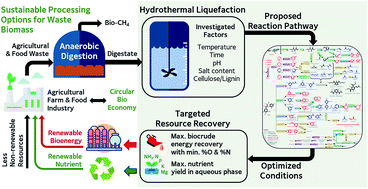Experimental-based mechanistic study and optimization of hydrothermal liquefaction of anaerobic digestates†
Abstract
Valorization of agricultural and food waste digestates is crucial for sustainable waste management to reduce environmental impacts and improve the economics of commercial farms. Hydrothermal liquefaction (HTL) of anaerobic digestates was evaluated to recover resources by converting them into carbon-dense biocrude oil and a nutrient-rich HTL aqueous phase (HTL-AP) coproduct. The effects of HTL temperature (280–360 °C), reaction time (10–50 min), feedstock pH (2.5–8.5), digestate salt content (1–5 wt%), and digestate cellulose-to-lignin ratio (0.2–1.8) on energy and nutrient recovery were systematically investigated in a set of well-designed experiments following a half-fractional central composite protocol. Response surface analysis combined with HTL product characterization and comparative literature study produced a comprehensive reaction pathway for HTL of anaerobic digestates. Moreover, this analysis revealed the importance of acidic feedstocks (pH 3.00–5.53), high reaction temperatures (337–360 °C), and reaction times <45 or 45–50 min for digestates with Cel/Lig >1 or <1, for maximizing the energy recovered in biocrude (high carbon yield and low heteroatom content) and the amounts of P, NH3–N, and Mg distributed in the HTL-AP. Acidic conditions catalyzed biocrude production, inhibited the Maillard reaction (lowering the nitrogen content in biocrude), and partitioned nutrients into the HTL-AP. Higher reaction temperatures coupled with longer reaction times activated hydro-denitrogenation and deoxygenation reactions to improve biocrude quality. This work provides not only validated methods to achieve targeted resource recovery for specific feedstock compositions using HTL, but also a comprehensive mechanistic understanding of the HTL of biomass waste for controlling target product characteristics.



 Please wait while we load your content...
Please wait while we load your content...
